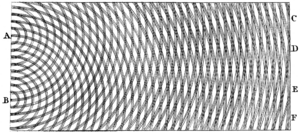Diffraction facts for kids
Diffraction is a cool idea in physics. It happens when waves bend or spread out. This can happen when they go around small objects. It also happens when they pass through tiny openings. All kinds of waves can diffract. This includes sound waves, water waves, and light waves. Even tiny bits of matter like electrons can show diffraction.
Contents
What Makes Waves Diffract?
Diffraction happens because a wave gets changed by an object. Imagine a wave hitting something small. The wave will bend or spread out. This bending makes the wave meet itself. When waves meet, it's called interference.
Interference can be two types:
- Constructive interference: This makes the wave stronger. The intensity of the wave goes up.
- Destructive interference: This makes the wave weaker. The intensity goes down, sometimes even disappearing.
These patterns depend on the size of the object. They also depend on the wave's size. Diffraction is strongest when the wave's wavelength is similar to the object's size.
How We Use Diffraction
Diffraction is very useful! We can use it to separate different colors of light. This is done with something called a diffraction grating.
Diffraction Gratings
A diffraction grating is like a special tool. It can be a piece of material with many tiny, close lines. Or it can be a mirror with small grooves. Diffraction gratings work because different colors of light bend at different angles. This makes them separate.
Diffraction gratings are used in many science tools. For example, they are in spectrometers. These tools help scientists study light and chemicals.
Looking at Molecules
Diffraction can also help us see tiny molecules. This is done using a method called X-ray crystallography.
In X-ray crystallography, scientists aim X-rays at a crystal. The crystal makes the X-rays diffract. This creates a special pattern. This pattern is unique to each type of crystal. Scientists can use it to figure out what molecule makes up the crystal. It helps them understand how molecules are built.
Images for kids
-
A solar glory on steam from hot springs. A glory is an optical phenomenon produced by light backscattered (a combination of diffraction, reflection and refraction) towards its source by a cloud of uniformly sized water droplets.
-
The Airy disk around each of the stars from the 2.56 m telescope aperture can be seen in this lucky image of the binary star zeta Boötis.
-
Following Bragg's law, each dot (or reflection) in this diffraction pattern forms from the constructive interference of X-rays passing through a crystal. The data can be used to determine the crystal's atomic structure.
-
Colors seen in a spider web are partially due to diffraction, according to some analyses.
See also
 In Spanish: Difracción para niños
In Spanish: Difracción para niños















